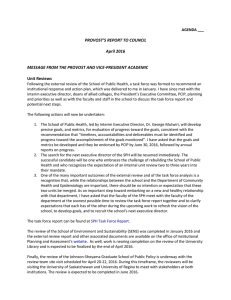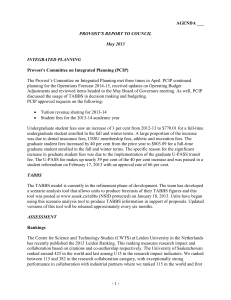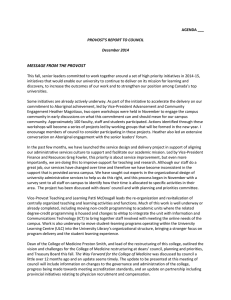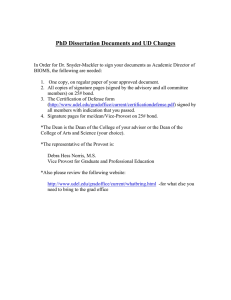Last academic year, 2011-12, was an especially busy time for... system; and a suite of new academic-innovation initiatives. These... AGENDA ___
advertisement
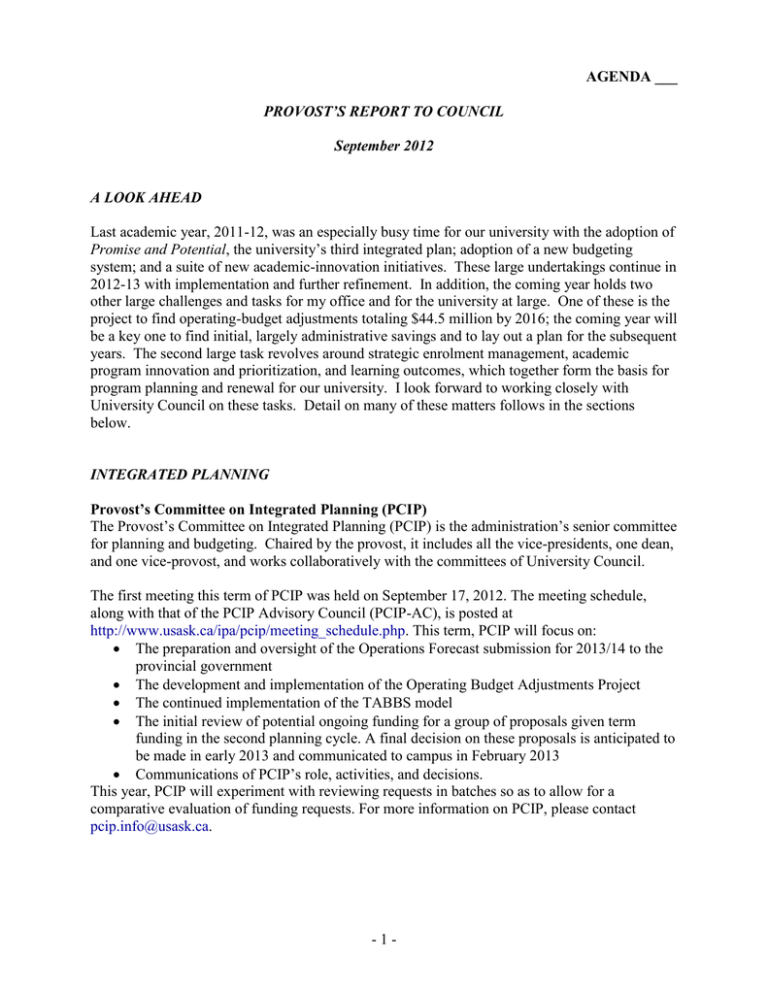
AGENDA ___ PROVOST’S REPORT TO COUNCIL September 2012 A LOOK AHEAD Last academic year, 2011-12, was an especially busy time for our university with the adoption of Promise and Potential, the university’s third integrated plan; adoption of a new budgeting system; and a suite of new academic-innovation initiatives. These large undertakings continue in 2012-13 with implementation and further refinement. In addition, the coming year holds two other large challenges and tasks for my office and for the university at large. One of these is the project to find operating-budget adjustments totaling $44.5 million by 2016; the coming year will be a key one to find initial, largely administrative savings and to lay out a plan for the subsequent years. The second large task revolves around strategic enrolment management, academic program innovation and prioritization, and learning outcomes, which together form the basis for program planning and renewal for our university. I look forward to working closely with University Council on these tasks. Detail on many of these matters follows in the sections below. INTEGRATED PLANNING Provost’s Committee on Integrated Planning (PCIP) The Provost’s Committee on Integrated Planning (PCIP) is the administration’s senior committee for planning and budgeting. Chaired by the provost, it includes all the vice-presidents, one dean, and one vice-provost, and works collaboratively with the committees of University Council. The first meeting this term of PCIP was held on September 17, 2012. The meeting schedule, along with that of the PCIP Advisory Council (PCIP-AC), is posted at http://www.usask.ca/ipa/pcip/meeting_schedule.php. This term, PCIP will focus on: The preparation and oversight of the Operations Forecast submission for 2013/14 to the provincial government The development and implementation of the Operating Budget Adjustments Project The continued implementation of the TABBS model The initial review of potential ongoing funding for a group of proposals given term funding in the second planning cycle. A final decision on these proposals is anticipated to be made in early 2013 and communicated to campus in February 2013 Communications of PCIP’s role, activities, and decisions. This year, PCIP will experiment with reviewing requests in batches so as to allow for a comparative evaluation of funding requests. For more information on PCIP, please contact pcip.info@usask.ca. -1- Update on Promise and Potential: the Third Integrated Plan For this planning cycle, on the recommendation of the office of Institutional Planning and Assessment (IPA), a phased approach to implementation will be undertaken. The current emphasis is on what can be reasonably accomplished in the first year of the planning cycle given the attention that will be required within the university to budgetary constraints. Implementation began over the summer with the appointment of several commitment leaders for roughly fifteen projects. I am currently in the process of approving terms of reference for the project commitments. As these are approved, they will be posted at www.usask.ca/plan. We will be using this website over the next four years to report progress on projects and metrics on a regular basis. This site also contains all of the college, school and unit plans and will also have their planning parameters once those documents are finalized in early November. It is our hope, in arranging this site, that planning documents will be readily available to the campus community and that we are able to ‘showcase’ all of the activity/initiatives which relate to the current plan in a ‘one–stop–shop’ format. ASSESSMENT INITIATIVES Achievement Record The 2012 version of the Achievement Record is currently in preparation and is anticipated to be released in the fall (late October/early November). It will be available online at www.usask.ca/achievementrecord and, similarly to last year, it will contain comprehensive university-wide information with benchmarks and targets, where appropriate, and also include detailed college-level data. Institutional Surveys The IPA is currently working on analyzing and summarizing data received over the summer from institutional surveys conducted in term two of the last academic year. This includes the Canadian University Survey Consortium (CUSC) survey of graduating students targeting students in their final year of study. The summary will include results on graduating students’ perceptions of university, their overall university experience, financing university education, arranged employment and future plans, and overall satisfaction. Results will be available on the IPA website www.usask.ca/ipa in the fall. A summary has also been drafted for the U of S results in the Saskatchewan Post-Secondary Follow-up Survey of 2009/2010 graduates conducted by the Saskatchewan Ministry of Advanced Education, Employment, and Immigration last fall. The summary will include information on satisfaction, financing university education, learning outcomes, employment outcomes, and further education for recent U of S graduates. The provincial government has instructed the U of S to await the official release of the results by the province. Closely following the provincial release, the IPA will post information including the U of S summary on the IPA website www.usask.ca/ipa. Rankings The IPA is continuing work on a major rankings project with the overall objective of improving the placement of the U of S in major national and international ranking systems. We are in the middle of a busy period for rankings with the results of rankings being released over the summer and continuing into the fall. In October, the results of two major rankings are expected to be -2- released: Globe and Mail Canadian University Report, and Maclean’s University Rankings. The IPA will ensure that factsheets including a summary of the latest U of S results with comparison to recent year’s results is posted on our website as close as possible to the national release of these rankings. Graduate Program Review The Strategic Directions commit the University of Saskatchewan to be a major presence in graduate education in Canada and to adhere to international standards in all that we do. Therefore, we expect our graduate programs to meet or exceed the quality standards demonstrated in similar programs at medical-doctoral and research-intensive universities across Canada and around the world. The university’s Framework for Assessment established the Graduate Program Review process as the primary instrument to assess the quality of our graduate program activities and outcomes. The academic review of graduate programs is one of the priorities for assessment at the University of Saskatchewan. For the 2012/13 academic year, a total of 13 graduate programs will participate in the review, including the graduate programs in the science division of the College of Arts and Science and all graduate programs in the College of Engineering. DISTRIBUTED LEARNING The acting vice-provost, teaching and learning is leading a major project this fall to develop a comprehensive university-wide strategy for distributed learning. The university has a strong tradition in distributed learning through programs like ITEP and our long-established partnership with regional colleges. More recently the new B. Sc. Nursing program – with simultaneous delivery of courses in five sites including two in northern Saskatchewan – shows the great potential for further development. The scope of the project includes development of an appropriate funding model to support U of S colleges to participate in distributed learning, and a governance structure to ensure that distributed learning is well-aligned with the academic mission of the university. The specific role of the Centre for Continuing and Distance Education (CCDE) will also be reviewed to ensure its role and mandate continue to support the over-all university strategy for distributed learning. The working groups for the project include representation from Planning and Priorities, Academic Programs, Teaching and Learning, and Academic Support committees of Council. OPERATING BUDGET ADJUSTMENTS As you know from the May 2012 financial town hall, the university faces a gap between our expenses and revenues projected to be $44.5 million per year by 2016. This gap is the result of our expenditures growing faster than our revenues. In response we have undertaken a campuswide strategy for financial stability and long-term prosperity. Many members of the campus community have offered suggestions and ideas related to cost savings and increased efficiencies. These, along with other potential expense-reducing actions, are being grouped into four key areas or quadrants (central administrative, distributed -3- administrative, central academic, distributed academic) which ensure that administrative and academic areas, both at the centre and distributed across functions/colleges/schools/units, will be considered. Revenue increases will also be part of the discussion. Several of the quadrant leaders and their work teams met over the summer and their preliminary thoughts and finding are being reviewed by a steering committee consisting of: myself, co-chair of the steering committee and co-leader of the central academic quadrant Greg Fowler, Acting Vice-President Finance and Resources, co-chair of the steering committee and co-leader of the distributed administrative quadrant Barb Daigle, Associate Vice-President Human Resources Division and co-leader of the central administrative quadrant Jay Kalra, Chair of University Council Laura Kennedy, Associate Vice-President Financial Services and co-leader of the central administrative quadrant Pauline Melis, Assistant Provost Institutional Planning and Assessment and operating budgets adjustments project lead Ivan Muzychka, Associate Vice-President Communications Dan Pennock, Acting Vice-Provost Teaching and Learning and co-leader of the distributed academic quadrant Alison Renny, Associate Dean of Undergraduate Programs, Edwards School of Business and co-leader of the distributed administrative quadrant Greg Smith, Member, Board of Governors and chair of board finance and investment committee Peter Stoicheff, Dean, College of Arts and Science and co-leader of the distributed academic quadrant Bob Tyler, Chair, Planning and Priorities Committee of Council and co-leader of the central academic quadrant Vicki Williamson, Dean, University Library and co-leader of the central administrative quadrant Ultimately, the steering committee will provide recommendations on actions to PCIP which will provide final recommendations to the Board of Governors. Our emphasis is to identify adjustments in a way that is deliberate and strategic: to make the right adjustments, in light of the university mission and planning, rather than the quickest adjustments. So far a number of relatively small changes have been made in central budgets; otherwise no decisions, changes, or adjustments have yet been made. I will commit to providing regular updates to University Council as the budget adjustments project progresses. ACADEMIC INNOVATION INITITATIVES You will recall that in October 2011 the Provost’s Committee on Integrated Planning (PCIP) committed $2.5 million in permanent, ongoing funding to meet several outstanding commitments from the Second Integrated Plan, and to further solidify the foundation for future priorities. A set of new, cross-unit initiatives – the Academic Innovation Initiatives – was announced. With an exciting mix of programming and services, these initiatives target two priority areas: curriculum innovation; and, Aboriginal engagement and community outreach. -4- One year later, I am pleased to present some of the progress being made in these areas. The Office of First Nation & Metis Engagement, located on the English River First Nation, held its grand opening in May 2012, profiling the colleges and units who have partnered to deliver programs and services to the Aboriginal community. The colleges of Agriculture and Bioresources, Medicine, and the Library are amongst the early champions who have targeted programs and resources. To date, over 50 groups and organizations have utilized the teaching and meeting space, which boasts First Nation & Metis art and the Library’s own Iportal community research tool. Other technology enhancements, supported by EMAP (Educational Media Access and Production), will enhance the upcoming Aboriginal Leadership Speaker Series, the Iportal Community Research sessions, and the GIS Engagement Map. The latter is designed to identify First Nation and Metis communities, treaty areas, current U of S engagement sites, and community program information. The Office of Community Outreach and Engagement, located at Station 20 West, is scheduled to open in mid-September and will be utilized by various campus programs as well as individual faculty, and graduate students on a rotating basis. Development of this office will assist in the ongoing strategy development for rural, distant and northern outreach and engagement and in linking outreach and engagement research with curriculum. Database sharing and GIS mapping of these activities, also currently under development, will better inform the goals of integrating community outreach and engagement, the student experience and faculty teaching, research and scholarship, making it easier for faculty and academic units to develop meaningful teaching and research partnerships with the broader community. On the curriculum innovation front work has focused on five broad categories. College-level initiatives in curriculum renewal or accreditation are currently focusing on the colleges of Arts and Science, Engineering, Law, and Pharmacy and Nutrition to enhance the student experience with improved accredited programming. Next, several new programs featuring certificates of proficiency or degrees are in the process of development ranging in their progression from already approved and deployed to preliminary discussion. The third area of focus has been on program level learning outcomes and curricular audits. These evaluation tools, which touch a variety of colleges and departments across the university, will serve our students and faculty well by providing valuable feedback for future teaching and learning enhancements and feeds well into the forth category, designing and development distributed and online learning resources in courses or programs. Again, touching a variety of units across the institution, at last count this initiative has seen seven new courses completed with at least another eight currently well into the development phase. And finally, the implementation of experiential learning into courses and programs is greatly enhancing the student experience. Currently there are eight specific classes and/or programs that are encouraging students to become active participants in their learning experience. By expanding their learning tools beyond the traditional textbook and classroom options, students and faculty alike are learning in exciting new ways and environments. STRATEGIC ENROLMENT MANAGEMENT PROJECT (SEM) One of the projects being implemented under the umbrella of Promise and Potential is the Strategic Enrolment Management (SEM) project, which began in November 2011. Various -5- committees have been working over the summer to develop persona group reports – a collection of qualitative and quantitative data on groups of students. Six reports have been prepared: Aboriginal, international, mature, transfer, direct from high school, and graduate. Members of the project team have also been working with Dr. Lynda Wallace-Hulecki (of SEM Works, an independent consultant working with the project team) to complete an enrolment goals analysis report which looks at U of S third planning cycle enrolment goals against internal and external enrolment trends and environmental factors affecting enrolment. It identifies enrolment gaps and opportunities for improvement in enrolment goal-setting, strategy development and future enrolment considerations. The persona group reports and the enrolment goals analysis report will inform the next phase of the SEM project: identification of strategic opportunities which will assist the university in achieving our 2015/16 enrolment goals. This next phase of the project will be primarily carried out between December 2012 and April 2013. All of these elements – the enrolment audit which took place November 2011, the persona group reports, the enrolment analysis report and the strategic opportunities – will inform the Strategic Enrolment Management Plan (2013 – 2016), expected in summer 2013. TRANSPARENT, ACTIVITY-BASED BUDGET SYSTEM (TABBS) TABBS was reviewed by the Board of Governors in June 2012, and approved such that the TABBS project development phase is considered complete, and that the TABBS model information be considered in resource decisions beginning in 2012/13. With the implementation of TABBS model, the model, including any refinements and review, will be the responsibility of PCIP. The coming year will see Phase III refinement and implementation of TABBS. Activities will include further refinement of data and data definitions, development of reporting, development of documentation for users of TABBS information, development of a prototype tool and integration of TABBS information in to resource decisions including the 2013/14 operating budget process. REVIEW OF THE SUSTAINING CAPITAL GRANT As noted in the 2012-13 annual capital plan, the Sustaining Capital Grant and the eight capital programs currently receiving funding from the grant will be reviewed to assess whether the allocation of funding from the Sustaining Capital Grant is meeting the strategic priorities of the university. The review will be undertaken by a review committee with membership from the Provost’s Committee on Integrated Planning Advisory Committee (2), Deans’ Council (2), and the Planning and Priorities Committee of Council (2). The review committee will be supported by the office of Institutional Planning and Assessment (IPA). -6- COLLEGE AND UNIT UPDATES College of Medicine This college remains a top priority for the university. As I have described on a number of occasions, the goals of our whole institution depend on our College of Medicine performing at a high level. For a number of years, we have faced unique issues that have proved resistant to satisfactory resolution. Council’s help and leadership have been instrumental so far in creating an expectation of change. At the May council meeting, the agenda item regarding the College of Medicine required a report from the provost and the dean at the September council meeting in regards to progress being made on the restructuring. That report is attached. The work of the acting dean and of the new Dean’s Advisory Committee is supported by my office through Martin Phillipson, who is now in a term appointment as Vice-Provost, College of Medicine Restructuring. Edwards School of Business The Edwards School of Business is pleased to report a robust registration in the MBA Program at the Nasser Centre in downtown Saskatoon. The program size doubled in 2011 to over 50 students and the 2012 registration exceeds 50 again. The gains in student numbers were achieved while also raising the profile of the incoming class by over 50 points in the GMAT. The MBA students launched a successful Grandey Leadership Initiative involving regular “fireside chats” with major business and political leaders. The Edwards School’s donors have helped develop a suite of MBA student scholarships to recognize the growth of the degree program. The Edwards School continues to admit almost 80 students per year into its two-year Masters in Professional Accounting degree, and MPAcc graduates have remarkably high success rates in the Chartered Accounting profession’s unified final examinations. College of Arts & Science Peta Bonham-Smith (Biology) has been appointed Vice-Dean, Science for a five-year term effective July 1, 2012. She had been Acting Vice-Dean, Science for the past two years. Kristina (Fagan) Bidwell, (English) and previously Assistant Dean, Aboriginal Affairs, has accepted a five-year term as the Associate Dean, Aboriginal Affairs, effective January 1, 2013. Bidwell is presently on a six-month sabbatical leave (from July 1– December 31) to work on her research programs with the aid of a SSHRC Public Outreach Dissemination (Aboriginal) grant. Linda McMullen (Psychology) has been appointed Acting Vice-Dean, Social Sciences for an 11-month period, effective August 1, 2012 to June 30, 2013. Harley Dickinson, Vice-Dean Social Sciences, has been seconded to a senior administrative position in the Office of the Vice-President Research during this time Erika Dyck, Canada Research Chair in the History of Medicine, had her research on the history of experimental use of LSD on the prairies profiled in University Affairs. Brian Pratt (Geological Sciences) and Keith Dewing of the Geological Survey of Canada, discovered a 25-kilometre-wide meteorite crater in the western Arctic -7- 2013 will mark the 30th anniversary of the Department of Native Studies at the University of Saskatchewan A team co-led by University of Saskatchewan researcher Colleen Anne Dell (Sociology) has been awarded nearly $1.2 million to examine the practice of traditional First Nations culture as a healing force within substance abuse programs, and develop tools to better understand and measure the impact of these cultural practices SEARCHES AND REVIEWS Search, Dean, College of Engineering The search for the Dean, College of Engineering will continue. Meetings to resume the search will be scheduled shortly. Search, Dean, College of Medicine There is currently no update available at this time. -8-
